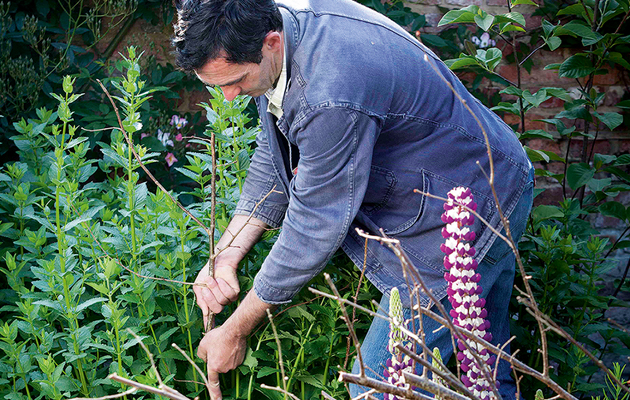April jobs for the English Cottage Garden
Troy Scott Smith stakes out the Cottage Garden


April is the signal for the garden to wake up properly; plants that have enjoyed winter dormancy start to froth in excited fecundity. Shuffling spires of lupins begin to show colour, peony buds slowly rupture, revealing their crinkled petals and a panoply of early perennials foam in broad swathes across the entire garden.
At this time of year (with the exception of the Lime Walk), the Cottage Garden is the most floral of Sissinghurst’s garden rooms. It is an intimate, enclosed space and, although visually connected to the rest of Sissinghurst, with views of the Elizabethan tower and the Tudor front range, it feels secluded. Harold and Vita considered it to be ‘our own little garden’, the innermost of what Harold called Sissinghurst’s ‘succession of privacies’.
Powerfully scented wallflowers underpin the spring display in the Cottage Garden. We sow them the previous June, lining them out in the nursery, before planting them into their flowering positions in the garden in mid October. Wallflowers, even at their best, can be scrappy plants, so pack them in—12 per square yard isn’t too many. It’s the overall effect that you’re after, not individual style and beauty.
I love the old-fashioned single-colour cultivars Blood Red and Fire King, but we also grow Vulcan for using in the Purple Border and Ivory White for the Rose Garden. They jostle for space with carpets of pansies, one of Vita’s favourite plants about which she said ‘I plant as many pansies as I can’ flotillas of iris and thickets of columbines. Vita called it ‘a muddle of flowers but all of them in the range of colours you might find in a sunset’.
Cheek by jowl with these humble spring stalwarts is woven the exotic—bulbs from the high lands of Persia and Turkey give a dash of concentrated colour and create a thread of succession between and through the garden rooms.
Elsewhere in the Cottage Garden, the jewel of our wildflower bulbs, Fritillaria meleagris, makes an unlikely partner for the emerging rugged leaves of Veratrum nigrum. Other delicate bulbs such as Iris reticulata or Scilla siberica are displayed in clay pots.
Gardening is at its most intense in spring and one of the most pressing tasks is staking. It’s one of those jobs that, when done well, should be unnoticeable; if not, the staked plant can look like a trussed-up chicken prepared for a Sunday roast. The aim is to support the stems of the plant, while still allowing its natural shape, form and habit to be evident. Timing is everything: stake too soon and the support will be visible; too late and the stems will have collapsed into something resembling a curled-up Yorkshire terrier.
Sign up for the Country Life Newsletter
Exquisite houses, the beauty of Nature, and how to get the most from your life, straight to your inbox.
In my experience, by far the best material for staking is supplied by indigenous hazel, Corylus avellana. The best way of ensuring you have an adequate supply of its twigs is to grow your own hazel coppice, as we do at Sissinghurst, allowing the coppiced plants to regenerate for a number of years before repeating the process.
When required as stakes, hazel should be coppiced every 3–5 years. At this interval, each stem will be large enough to use, but not too fat to push easily into dry ground; it will also be sufficiently furnished with good twigs for finer staking material.
The ideal time to coppice hazel is soon after the leaves have fallen in the autumn, for, if you leave it too late, the catkins begin to expand and the ripening wood becomes less pliable.
Using a sharp pruning saw, cut each stem in turn as low as possible until the whole shrub is cut. Then, using a billhook, each hazel stem can be worked to provide sticks of all sizes.
Try to avoid any waste. The short, stubby lengths with minimal branching are ideal for lupins and longer, well-branched sticks can be graded into various lengths for general staking. The feathery tips can be used for less robust plants such as aquilegias and irises and any straight, unbranched sections can be used for Vita’s beloved ‘minarets’, such as eremuruses and delphiniums.
Troy Scott Smith is head gardener at Sissinghurst, Kent
Country Life is unlike any other magazine: the only glossy weekly on the newsstand and the only magazine that has been guest-edited by HRH The King not once, but twice. It is a celebration of modern rural life and all its diverse joys and pleasures — that was first published in Queen Victoria's Diamond Jubilee year. Our eclectic mixture of witty and informative content — from the most up-to-date property news and commentary and a coveted glimpse inside some of the UK's best houses and gardens, to gardening, the arts and interior design, written by experts in their field — still cannot be found in print or online, anywhere else.
-
 Rodel House: The Georgian marvel in the heart of the Outer Hebrides
Rodel House: The Georgian marvel in the heart of the Outer HebridesAn improving landlord in the Outer Hebrides created a remote Georgian house that has just undergone a stylish, but unpretentious remodelling, as Mary Miers reports. Photographs by Paul Highnam for Country Life.
By Mary Miers
-
 380 acres and 90 bedrooms on the £25m private island being sold by one of Britain's top music producers
380 acres and 90 bedrooms on the £25m private island being sold by one of Britain's top music producersStormzy, Rihanna and the Rolling Stones are just a part of the story at Osea Island, a dot on the map in the seas off Essex.
By Lotte Brundle